

Max Davies
How Audi, BMW, Honda, Mercedes-Benz, and Suzuki started out in Australia, and where they are now
15 Hours Ago
The Suzuki Vitara is getting on a bit in 2023, so how does it fare against fresher competition? We test the Turbo AllGrip version to find out.
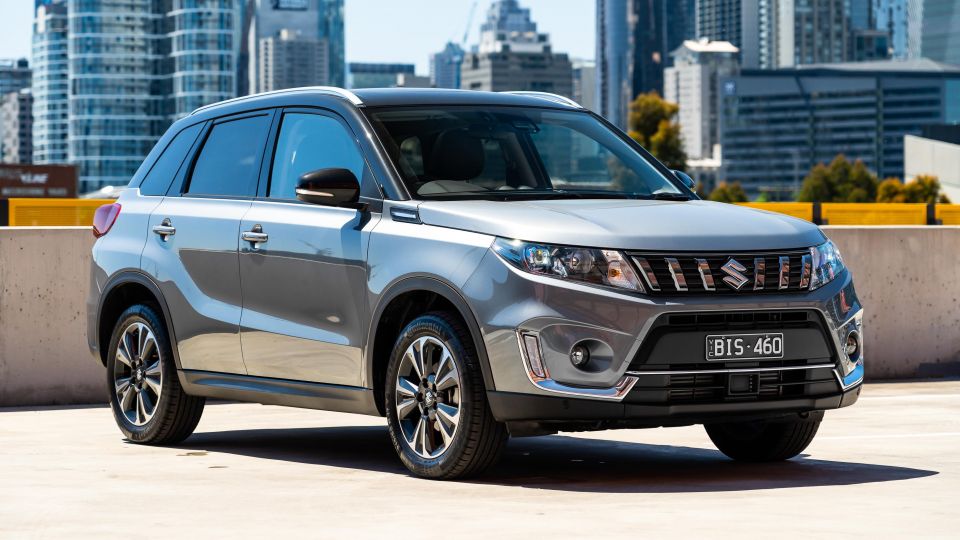
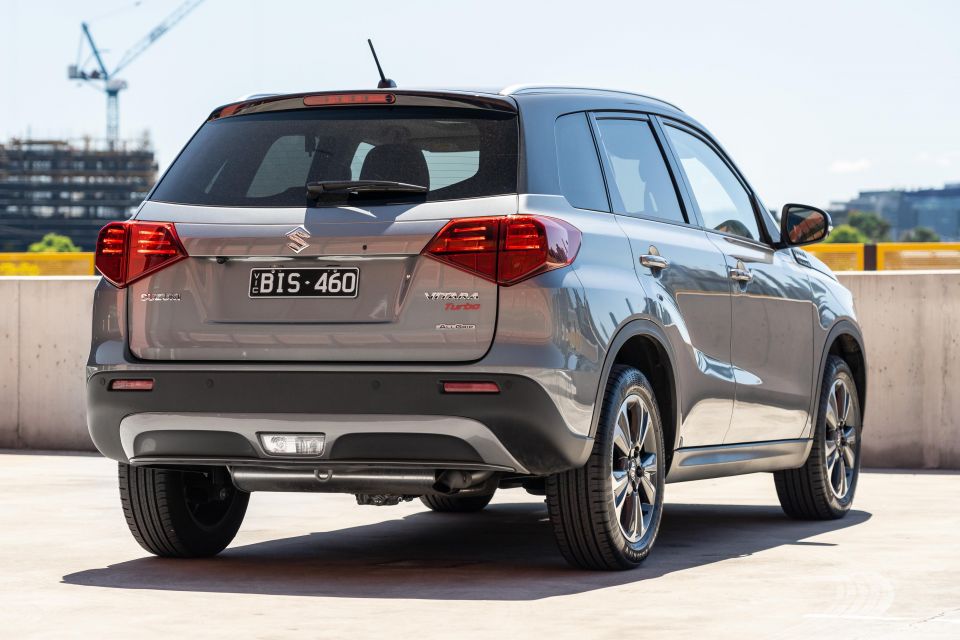

Quickly see how this car stacks up against its competition. Select any benchmark to see more details.
Where expert car reviews meet expert car buying – CarExpert gives you trusted advice, personalised service and real savings on your next new car.
The Suzuki Vitarahas been around in fourth-generation guise since the mid-2010s, and is a bit different in concept to its predecessors.

Where its forebears were more focused on being affordable, go-anywhere baby 4x4s, the current iteration is more of a jacked-up hatchback, sharing its DNA with the likes of the S-Cross.
Now in the later stages of life, the Hungarian-sourced Vitara Series II is one of the elders in the small SUV segment, older than all but the comparatively ancient Mitsubishi ASX (which first hit production in 2010).
The Vitara isn’t immune to price rises either, despite its age. Here on test we have the most expensive variant currently on sale – the 2023 Suzuki Vitara Turbo AllGrip (AWD), which will set you back a cool $42,990 drive-away.
It’s not uncommon for high-spec compact crossovers to have a price starting with a ‘4’… but as we’ll explain, the top-spec Suzuki is really starting to fall out of the race compared to its competitors, especially when you factor in its lofty price point.
The car you see here starts from $42,990 drive-away in Victoria.
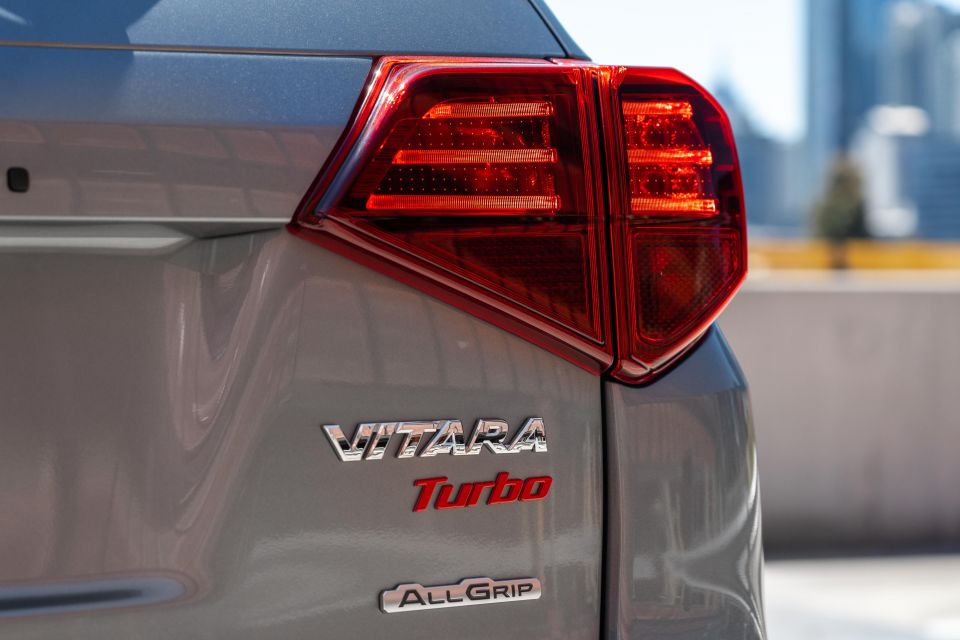
2023 Suzuki Vitara pricing:
Prices exclude on-road costs, drive-away pricing in brackets
It’s by far the dearest variant currently on sale in Australia, with the AllGrip all-wheel drive system commanding a hefty $4000 premium over the Vitara Turbo 2WD which is otherwise pretty much identical in spec.
At this end of the market the Vitara is duking it out with mid- to high-spec versions of the Hyundai Kona, Kia Seltos, Mazda CX-30, Nissan Qashqai and Toyota Corolla Cross. The cheapest (but effectively mid-spec) Volkswagen T-Roc Style is also similar money.
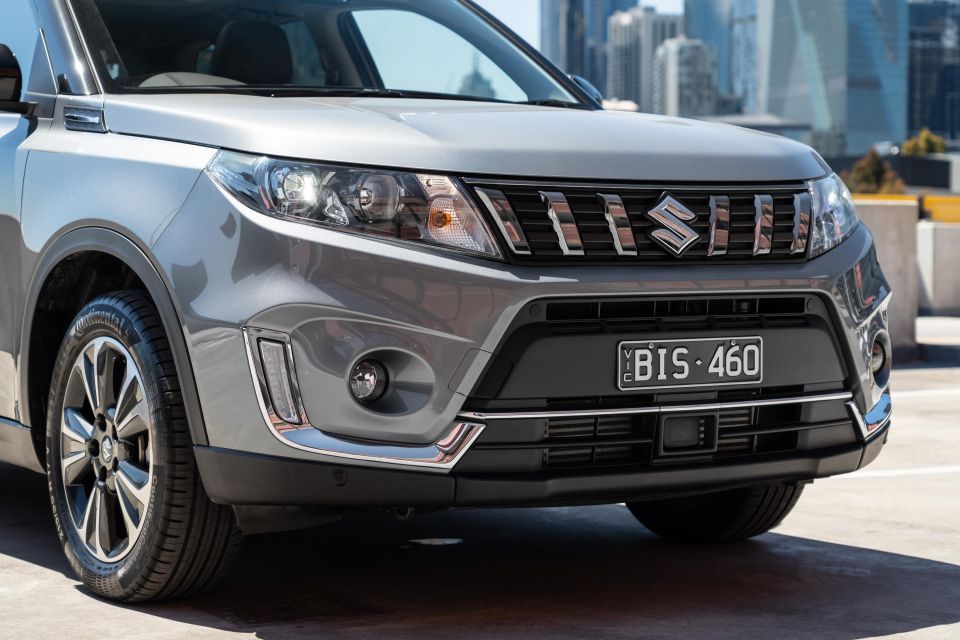
To add insult to injury, when the facelifted Vitara range first lobbed Down Under in 2019, the Turbo AllGrip was priced from $33,990 before on-road costs – that’s a $4000 mark-up in three or four years, with effectively no changes to spec.
The Vitara’s Hungarian production means it’s subject to European import tariffs, where its Asian-sourced rivals are not.
Buy your new car without the stress. It's fast, simple and completely free.

Great service from Travis and team, second time I have used this business would not hesitate to recommend them to anyone
Craig C.
Purchased a Ford Ranger in Sunshine Coast, QLD
CarExpert helped Craig save thousands on his Ford Ranger, now let us save you on your next new car.
Find a dealIn a world where so many vehicles are moving to display-heavy, button-less cabins, the Vitara’s cockpit remains nicely conventional and functional – if uninspiring.
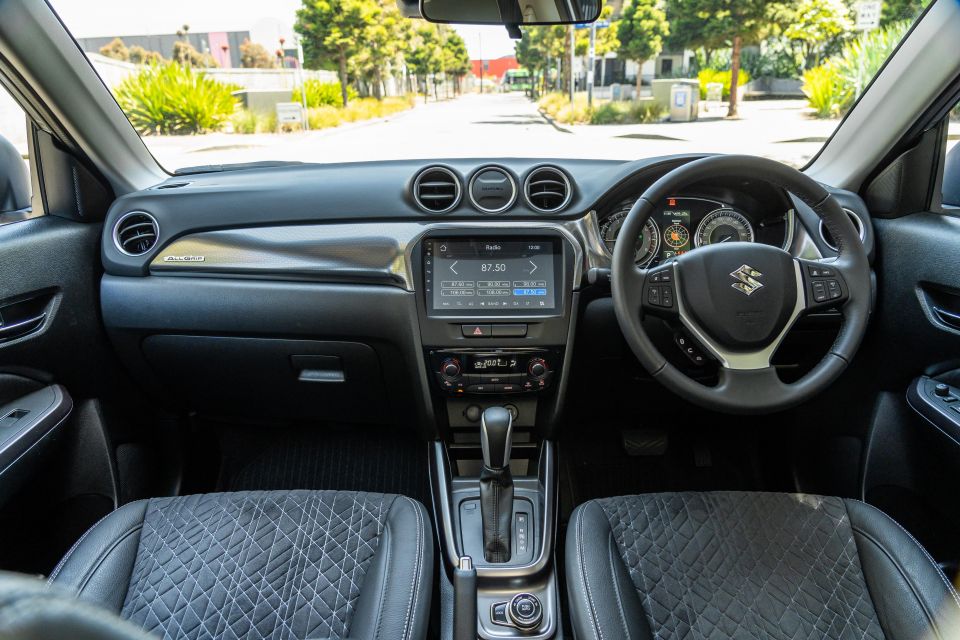
Not much has changed since the Series II model launched globally in 2018, though Australian models recently received a different infotainment unit in the wake of semiconductor-related component shortages.
The 9.0-inch touchscreen is a locally-fitted solution that has been in place from late 2021; this unit now does service in just about every local Suzuki model bar the Jimny Lite, Swift Sport, and new S-Cross.
It’s an upgrade over the old 7.0-inch OEM unit in the sense its got an extra 2.0 inches of display real estate, and it retains the outgoing display’s wired Apple CarPlay and Android Auto functionality. It does, however, lose factory satellite navigation.
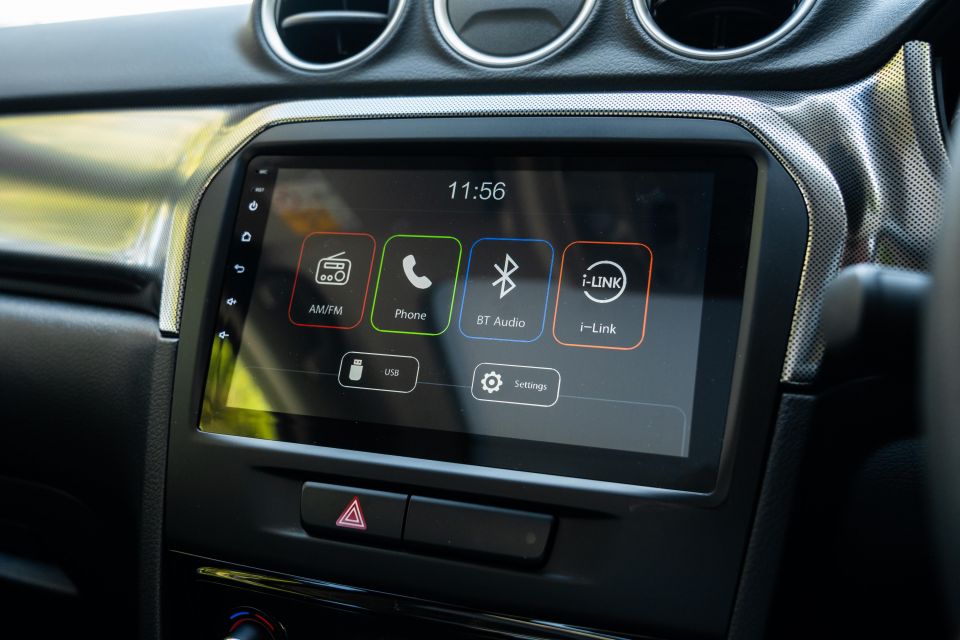
The interface is a little pared back compared to the Suzuki-supplied unit, and the icons and fonts reveal the display’s third-party origins.
It’s a little slow and laggy, and I found anyone I spoke to on the phone complained about audio quality because the microphone is mounted on the display (on the passenger side, no less) and not ahead of the driver.
Vitara Turbo models score two additional tweeters on top of the base model’s four-speaker audio system, but it’s hardly the last word in audio quality. Crank it up too loud and you’ll find the thin cabin plastics start to shake and vibrate, as do the windows.
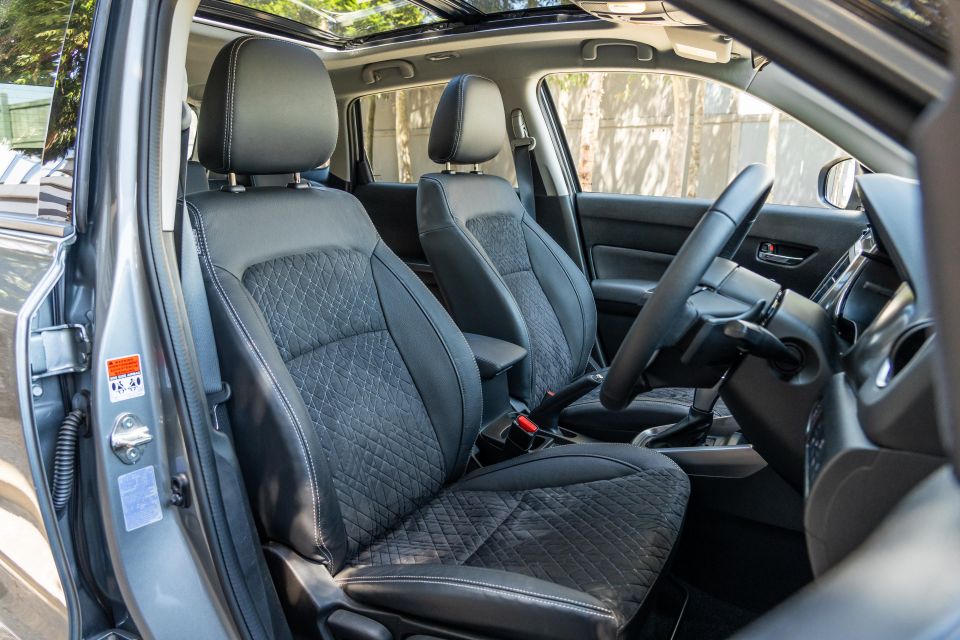

On the topic of build and material quality, the Vitara’s cabin hardly feels plush given its pricing and European origins.
The facelift brought a soft-touch dash top, which is a welcome upgrade, but the rest of the cabin is shod with hard, shiny, cheap-feeling plastics that don’t feel up to task when something like a Mazda CX-30 or Nissan Qashqai are furnished well enough to make an entry-level Audi or Mercedes nervous.
I will praise the seats, which are finished in a leather-accented and suede combination, with the latter featuring a stitching pattern that resembles a tyre tread. I think that’s pretty cool.
The seating position is quite high, and while there’s decent manual adjustment for the driver’s seat and steering wheel, the AllGrip’s panoramic sunroof eats into headroom quite a bit in both rows.

Storage isn’t a strong point either, with a shallow shelf below the centre stack that has larger phones jutting out and smaller items like keys sliding around, while the squared off cupholders between the front seats are an odd size and shape.
An average-sized bin under the centre armrest and small door bins with bottle holders round out the storage solutions up front.
The plastic manual handbrake and basic-looking gearshifter feel quite cheap. It’s just feeling dated, and a bit undercooked compared to the competition these days.
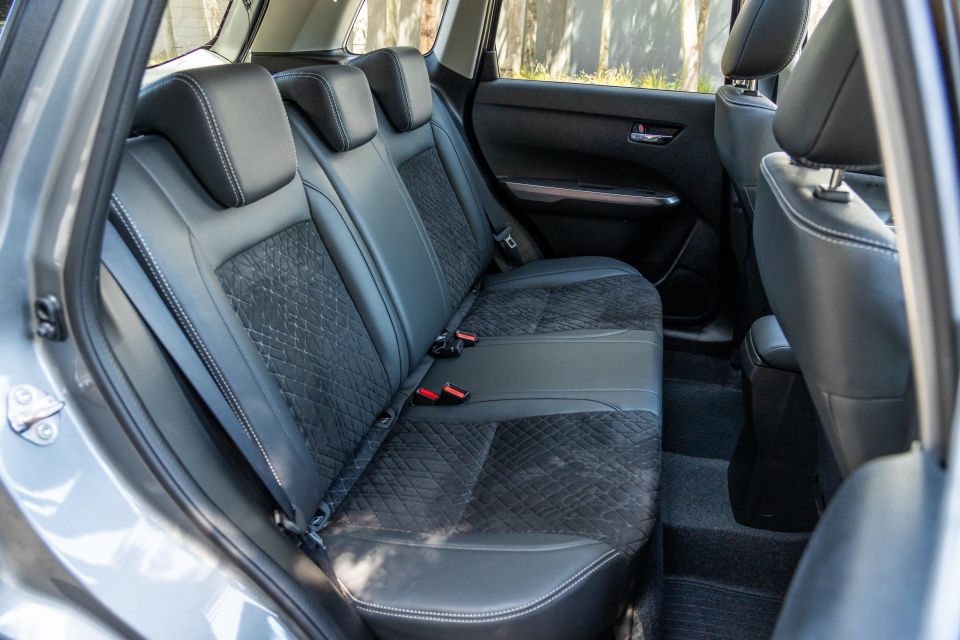
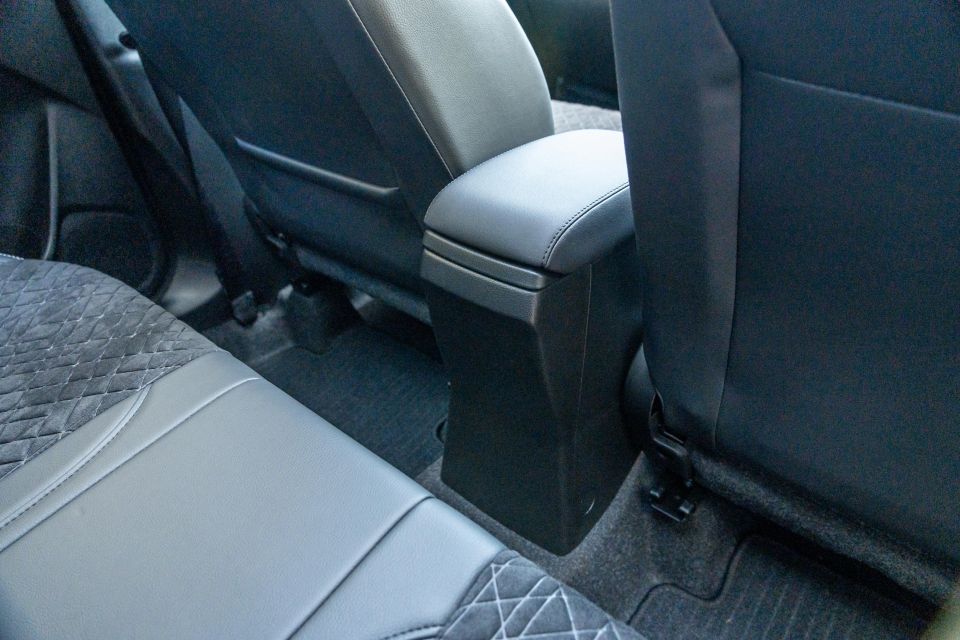
In the second row the Vitara again is starting to show its age compared to better packaged and furnished competition.
This is one of the smaller vehicles in its class, and that’s definitely clear if you’re six foot or above. Knee room behind a taller driver (I’m 6’1) is quite tight, and headroom is pretty compromised with that panoramic glass roof.
You’ll also find no rear air vents, no map pocket behind the driver’s seat, and no fold-down centre armrest. It’s quite spartan, but there are bottle holders in the doors.
There are ISOFIX anchors on the window seats and top-tether points across all three rear positions, so the kiddies are catered for.
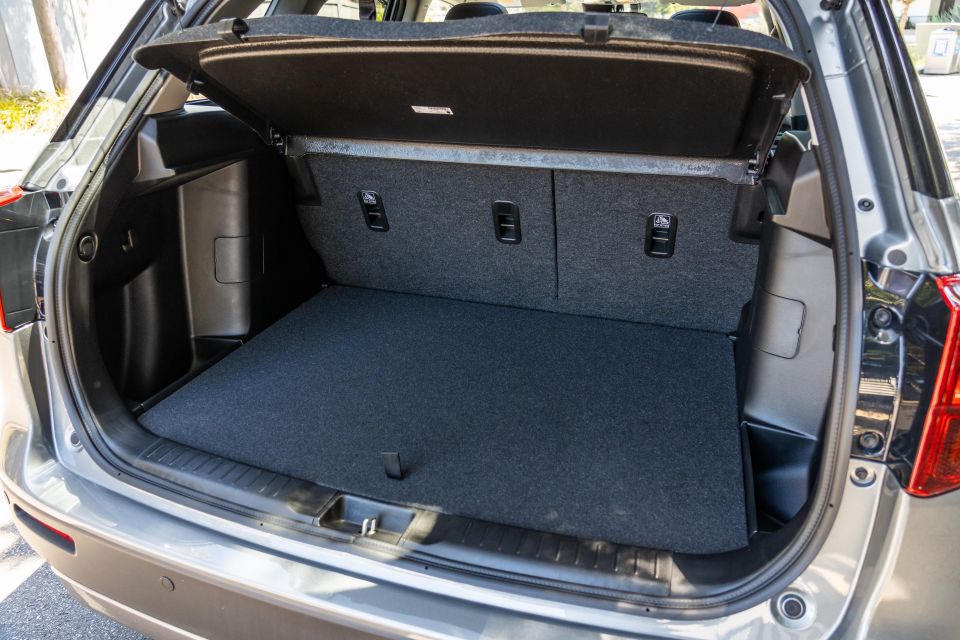
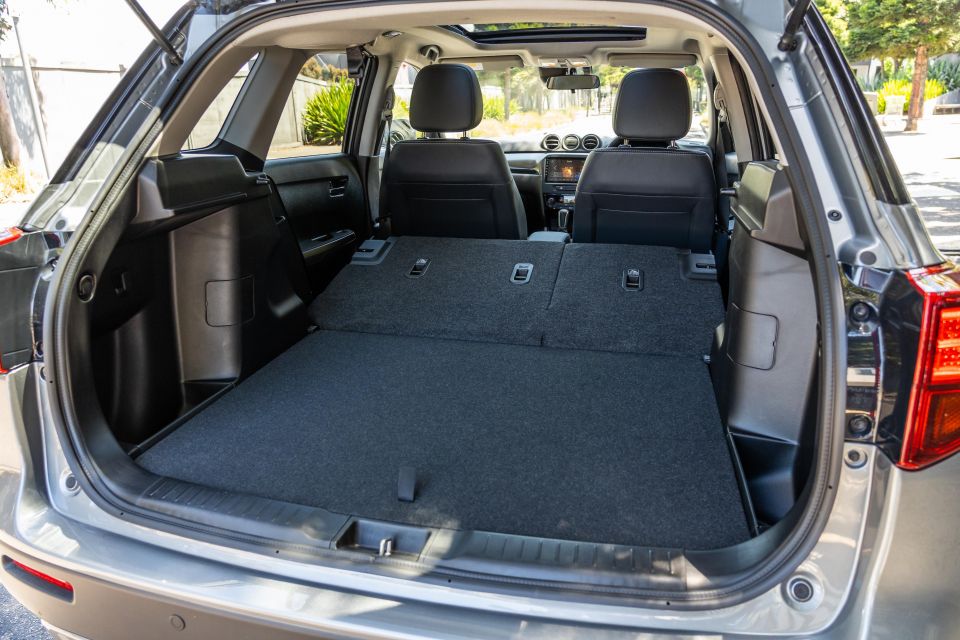
In the boot, the Vitara’s boxy design helps it claw back some ground.
At 375 litres in five-seat configuration, the Suzuki’s boot is larger than a number of more style-led competitors, and is a match for small hatchbacks like the Volkswagen Golf – though a Kia Seltos or Nissan Qashqai offer over 50 litres more capacity.
Drop those rear seats and Suzuki quotes a relatively small 710-litre maximum figure. Despite the below-average volume quote the space itself is tall and square, and while the rear seats aren’t completely flat when folded there’s no awkward step up from the boot floor to the seat backs.
A space-saver spare wheel lives under the luggage area floor.
Vitara Turbo models get a 1.4-litre BoosterJet four-cylinder turbo petrol engine, developing 103kW (5500rpm) ad 220Nm (1500-4000rpm).
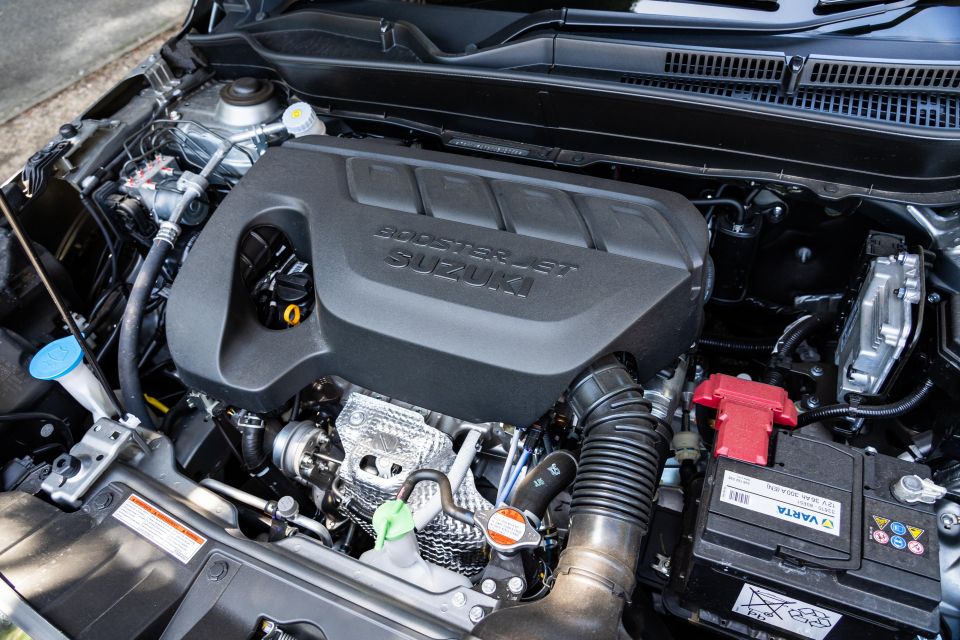
While those outputs don’t seem particularly impressive on paper, the Vitara Turbo’s relatively lithe 1235kg kerb weight in this spec (1160kg for the 2WD) mean the engine feels a lot punchier than it looks on paper.
Drive is sent to an on-demand all-wheel drive system via a six-speed automatic transmission in this spec, though as mentioned earlier you can also get the Vitara Turbo with front-wheel drive as well.
Suzuki claims a combined fuel economy figure of 6.2L per 100km for the Vitara Turbo AllGrip (5.9L/100km 2WD), with 95 RON premium unleaded required for its 47-litre fuel tank. It carries a combined emissions rating of 145g/km.
The AllGrip AWD system doesn’t bring any added towing capacity, at maximum 1200kg braked.
Forgive me if I’ve sounded a little negative so far, but the Vitara makes up ground once you get it on the road.
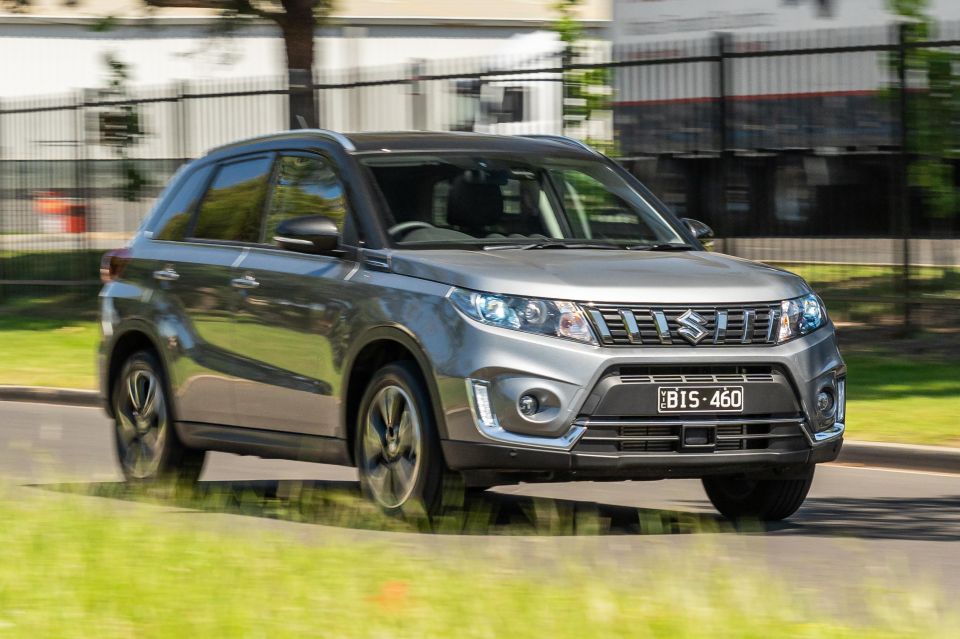
In typical Suzuki fashion, its light weight and responsive driver controls make this boxy little crossover a fun and chuckable thing that’s a doddle to commute in, and a bit of fun to send through some bends.
The steering is quick and accurate, and there’s a natural level of body lean that adds to the charm. Plus, there’s the BoosterJet petrol engine that adds a bit of zest.
With all 220Nm available from just 1500rpm the Vitara Turbo effortlessly gets along in city traffic, with both off-line and rolling acceleration responsive and meaty from down low.
The six-speed auto does a good job keeping the 1.4-litre engine in its sweet spot, while also shuffling through the cogs to aid efficiency.

Having all-wheel drive on hand also means this Vitara Turbo is less susceptible to torque steer and understeering than its 2WD equivalent, though it’s still not immune to scrabbling for grip if you gun it from the lights.
It rides nicely, with a softly-sprung tune that does a good job isolating occupants from the lumps and bumps of urban and city life. It’s also quite settled on the freeway.
While it steers and rides pretty well, the Vitara suffers another typical Suzuki trait which is lack of refinement – particularly on the highway.
Road noise is quite noticeable on rougher surfaces, and you can get a bit of wind buffeting too. It just doesn’t feel anywhere near as insulated as most rivals in the segment.
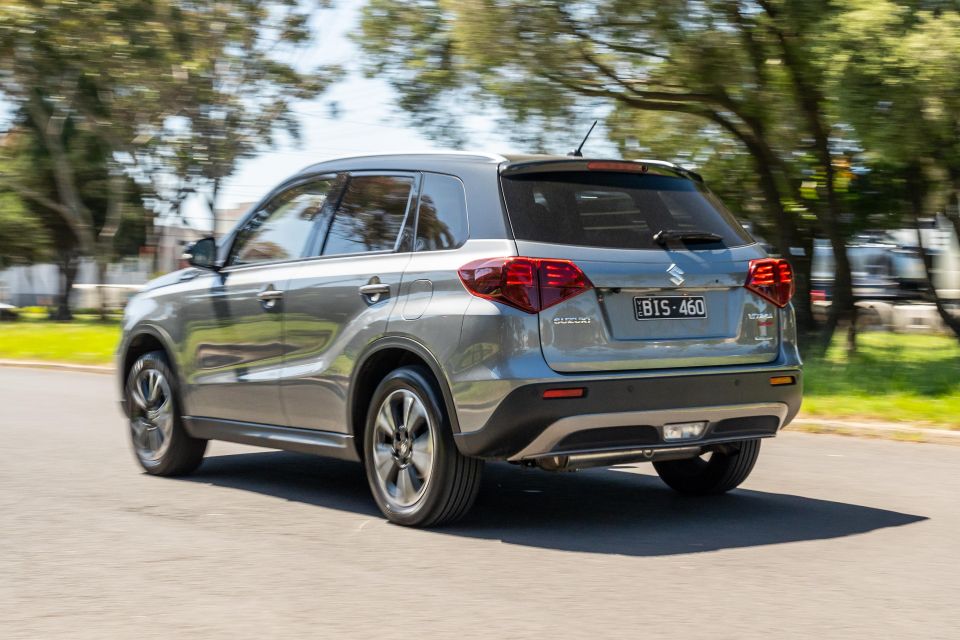
Where expert car reviews meet expert car buying – CarExpert gives you trusted advice, personalised service and real savings on your next new car.
The Vitara is also short on driver assistance tech compared to the wider segment, which is disappointing given the AllGrip’s price point in 2023.
It has a basic adaptive cruise control that cuts out under 30km/h, and can at times struggle to maintain the set speed going down hills. Speaking of hills, upgrading to the AllGrip adds hill descent control.
There’s handy blind-spot monitoring and rear cross-traffic alert, but the standard lane departure warning (no assist) is well short on what the bulk of the segment offers – most offer semi-autonomous functionality these days.
Vitara Turbo AllGrip highlights:
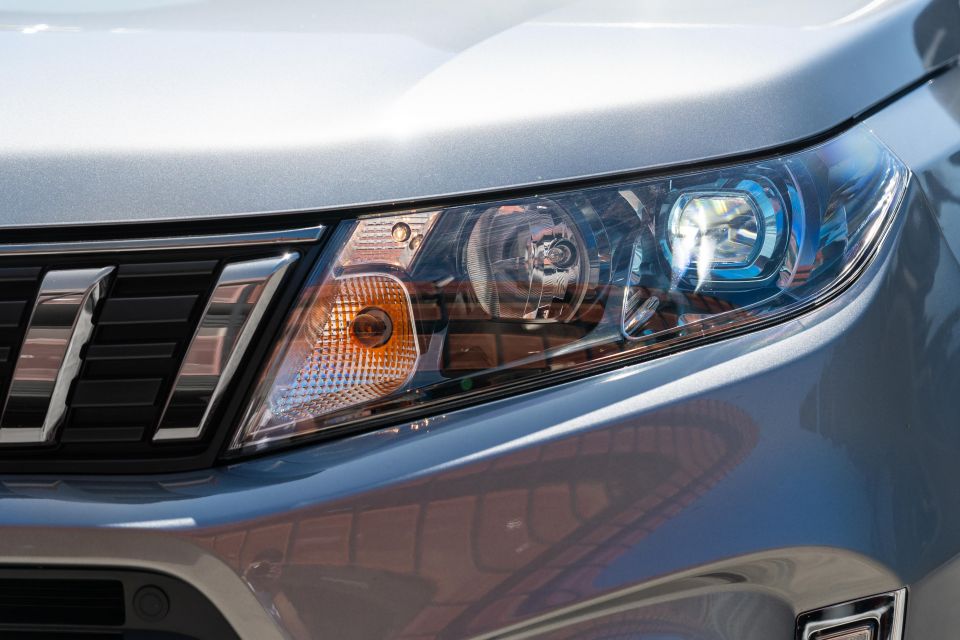



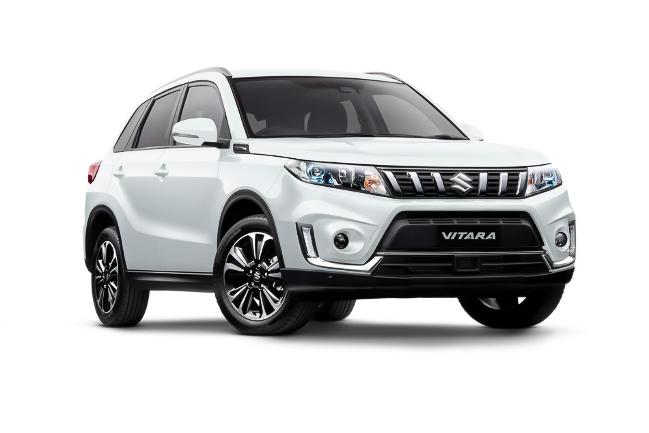

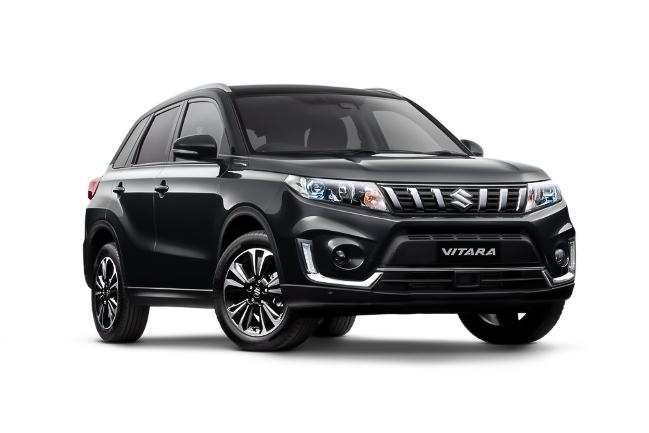
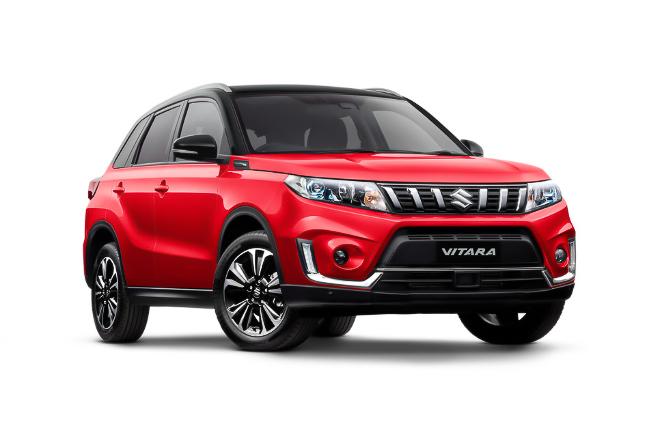

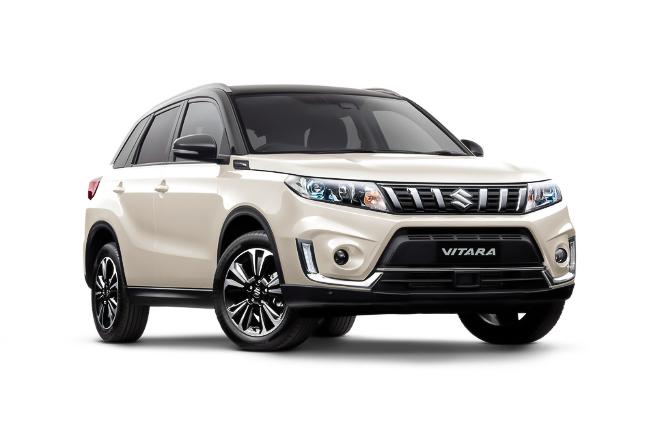
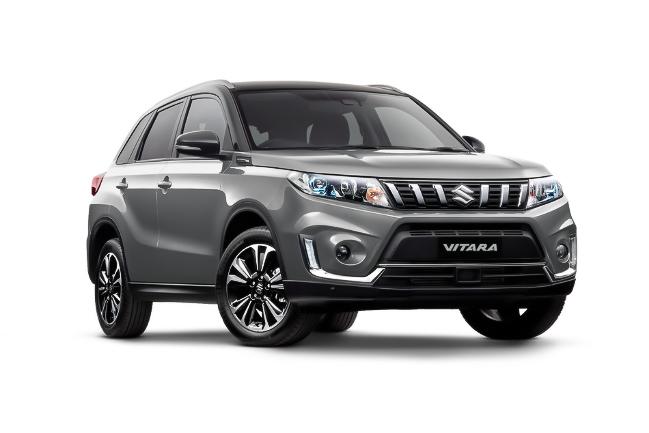
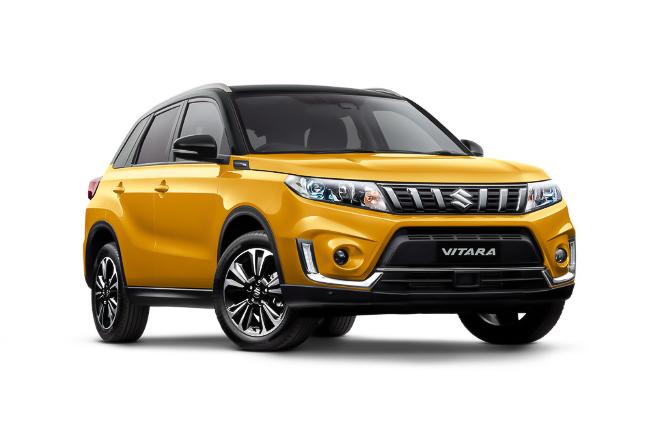
*Premium/Metallic paint $695 extra *Premium two-tone paint $1295 extra
As of January 1 2023, the Suzuki Vitara range is unrated in Australia. Vehicles built before January 1 wear a five-star ANCAP safety rating, based on 2015 tests against older criteria.

Against the superseded scoring system, the Vitara managed 35.79 out of 37, including perfect scores in the Side Impact (16/16) and Pole (2/2) assessments. Whiplash and pedestrian protection were rated as Good.
It’s worth noting that active safety assists were not a requirement to get a five-star rating when the Vitara was originally tested, as the base grade does without features like AEB and lane departure warning.
Standard safety features include:
Vitara Turbo adds:
Suzuki Australia covers its range with a five-year, unlimited-kilometre warranty.

Additionally, the Japanese brand includes up to five years of complimentary roadside assistance on the condition the vehicle is maintained according to the service schedule with a Suzuki dealer.
Speaking of, scheduled maintenance is required every 12 months or 10,000 kilometres – whichever comes first. Suzuki offers capped-price servicing for up to five years or 100,000 kilometres, again whichever comes first.
For the first 60 months or 50,000 kilometres, each visit for the Vitara Turbo will cost $329, $429, $339, $539, $349 for a total of $1985.
When makers like Toyota and Honda are charging around $200 per year for five years, it makes the Suzuki seem expensive. With that said, Kia and the Europeans will charge you similar or more.
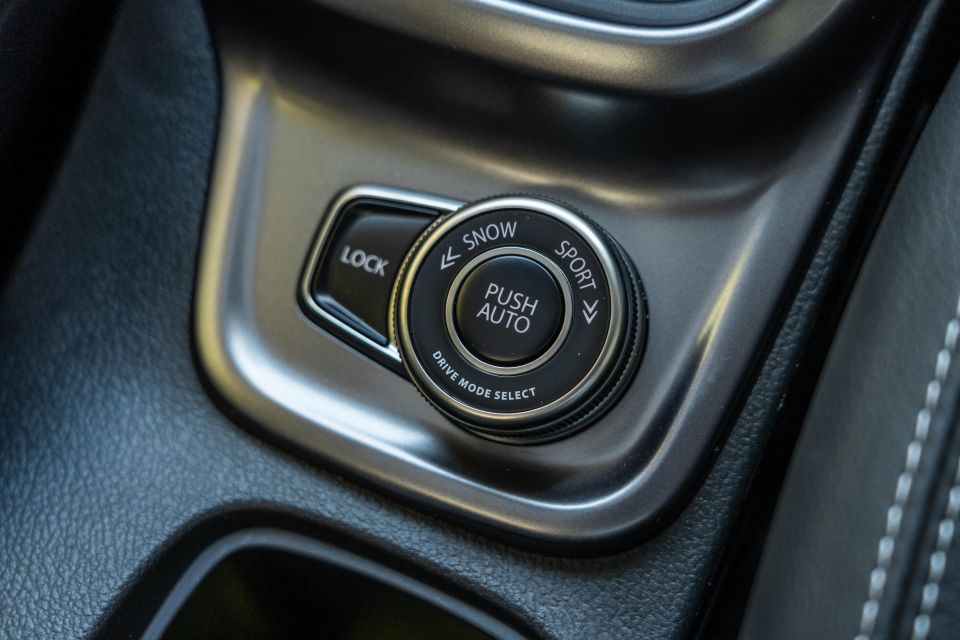
As for real-world fuel consumption, I managed an indicated 8.0L/100km during my week of mixed driving, which included some freeway stints as well as regular peak-hour commuting.
That’s a bit up on Suzuki’s 6.2L/100km claim, which isn’t helped by the lack of fuel saving technology like idle stop/start.
Overseas, Suzuki offers the 1.4L BoosterJet Turbo as a Mild Hybrid with small battery and electric motor, as well as a Full Hybrid which combines a 1.5L naturally-aspirated petrol engine with a motor-generator and battery.
There’s still appeal in the Suzuki Vitara, just not in this particular specification.
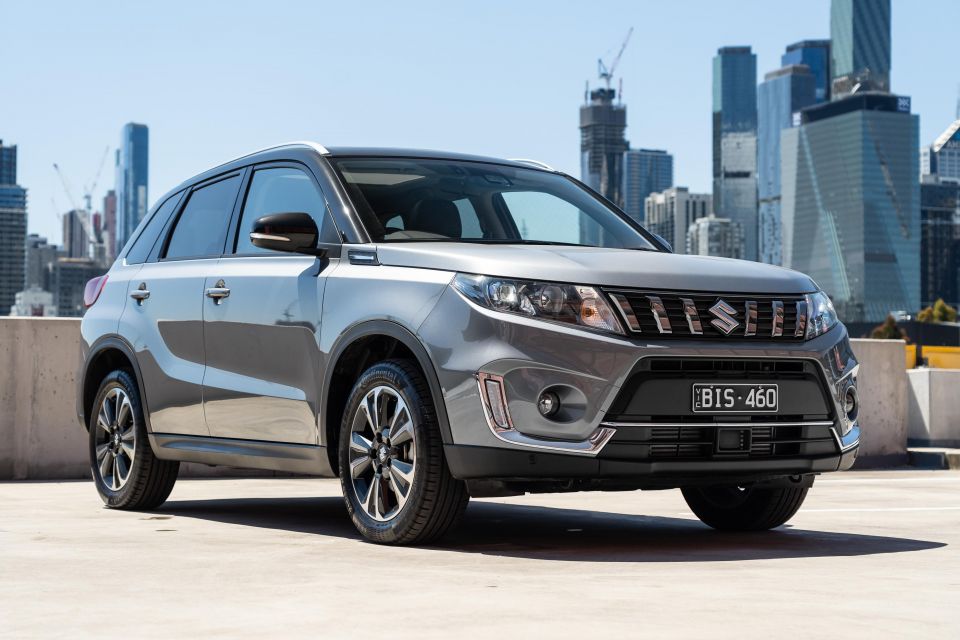
In Turbo AllGrip guise, the Vitara is simply too expensive relative to the current competitor set. It lacks the tech, features, space, quality and refinement expected of a compact SUV costing more than $40,000 on the road.
The switch in infotainment systems has also brought with it usability and feature compromises, and the AllGrip’s panoramic sunroof also eats into headroom.
While the Vitara isn’t a top pick in 2023’s small SUV class, the Turbo 2WD is a relatively attainable, economical and fun crossover to get about in, and is much better positioned against its competitor set. That’d be my pick of the range.
It’s a shame Suzuki hasn’t brought any of the electrified models offered overseas, as in the Australian market it’d be something of a unique proposition and an alternative to supply-stricken Toyota.

Click the images for the full gallery
MORE: Everything Suzuki Vitara
Where expert car reviews meet expert car buying – CarExpert gives you trusted advice, personalised service and real savings on your next new car.
James Wong is an automotive journalist and former PR consultant, recognised among Australia’s most prolific motoring writers.


Max Davies
15 Hours Ago


William Stopford
15 Hours Ago


Derek Fung
16 Hours Ago


Max Davies
23 Hours Ago


William Stopford
2 Days Ago


Ben Zachariah
2 Days Ago